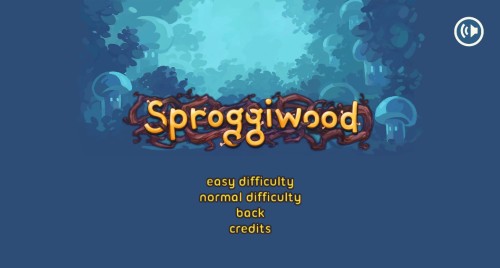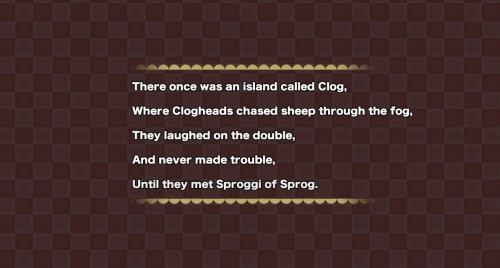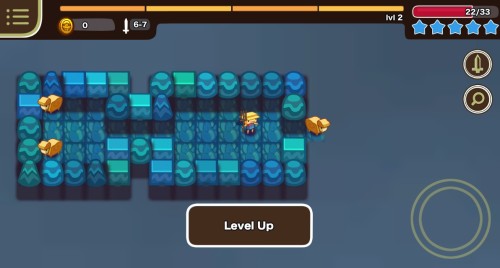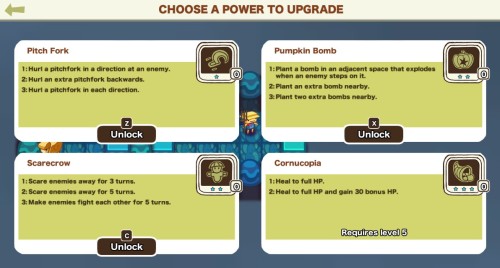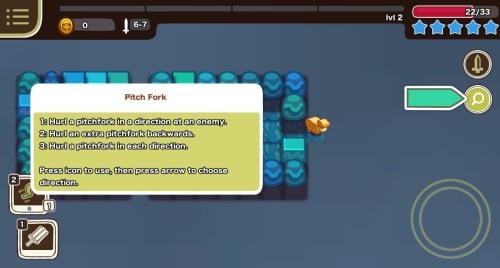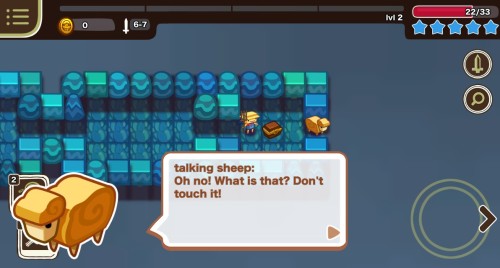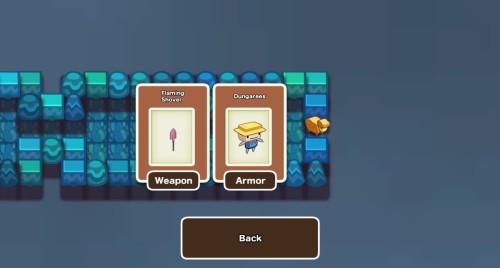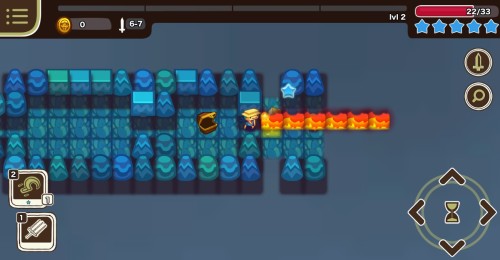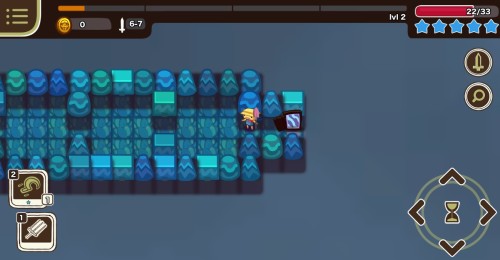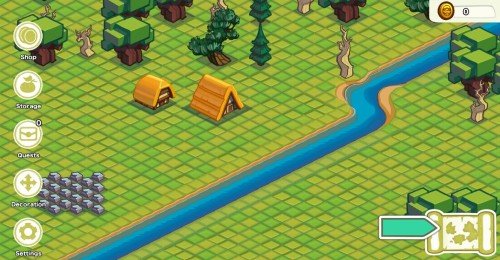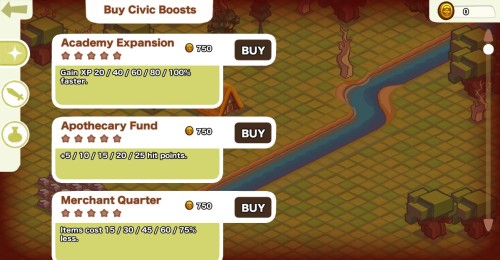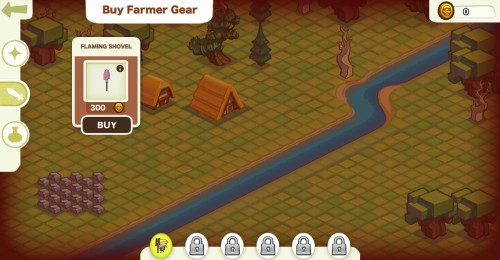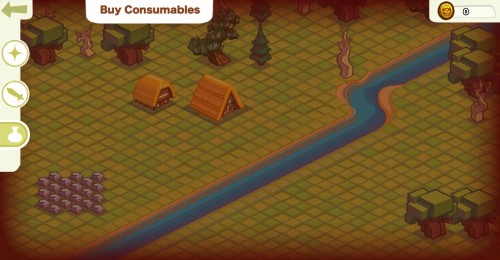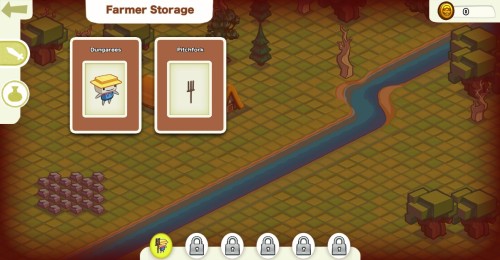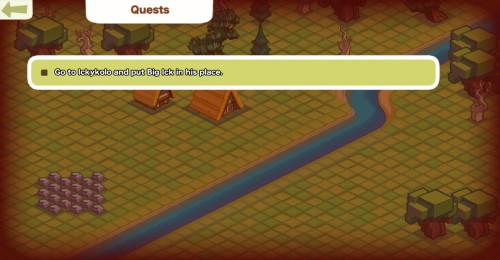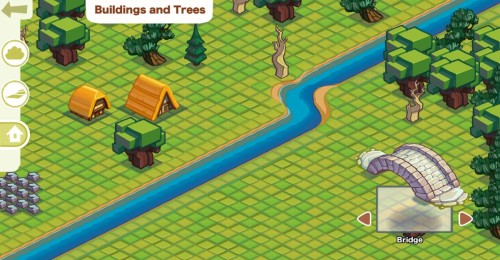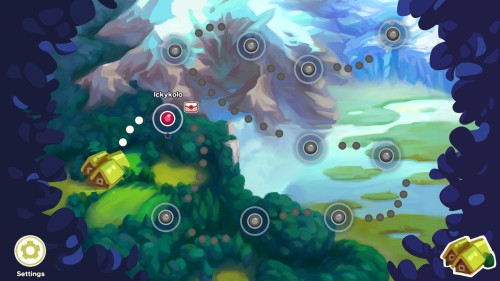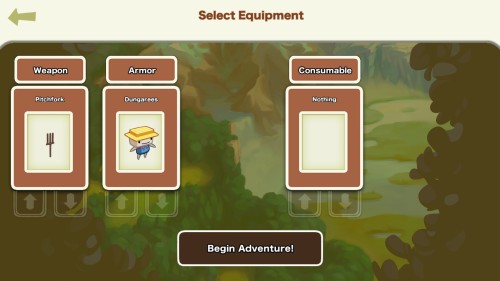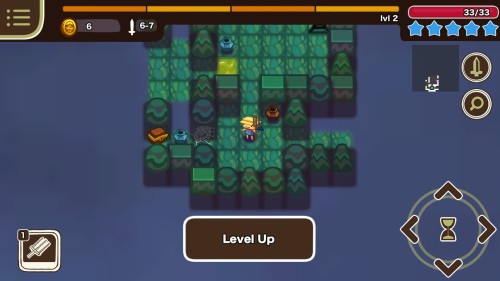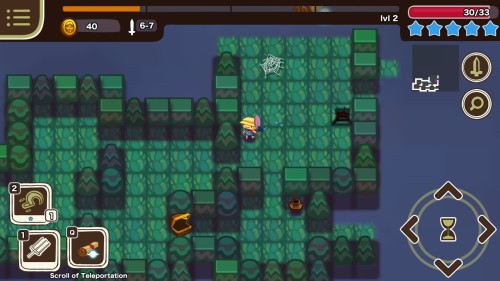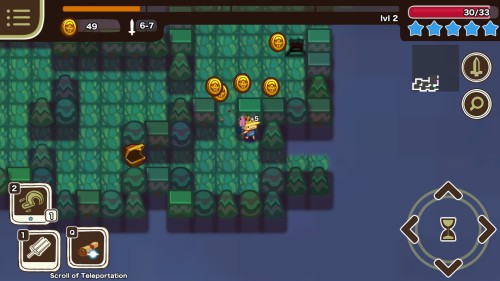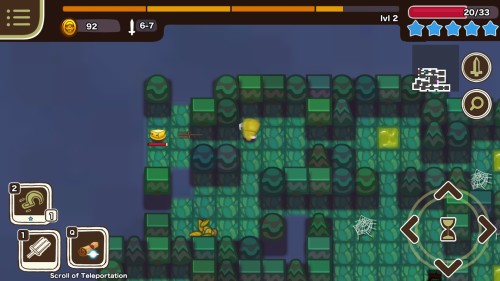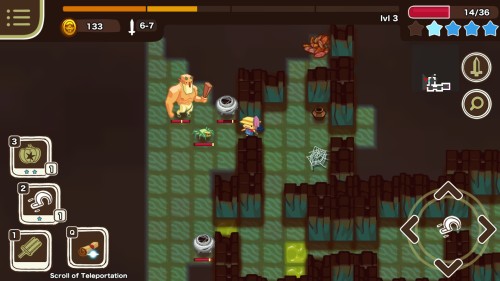The purists might jump on the title like a pack of hyenas, so I’ll put a disclaimer right here and now – some might not consider Sproggiwood a roguelike. I do, but some might not. Most will consider it a fun game to play, though.I know I do, so I’ll do my usual “what is this game about” thing. I was going to do it earlier, before the game was released, but I couldn’t find the time, so let’s do it now that it’s out.
What is Sproggiwood about?
It’s a roguelike.
That doesn’t mean a lot these days, so here’s what it’s actually about.
You have a village. You have a story that involves a bunch of dungeons. You tackle these dungeons one at a time and on each completion, you get a bunch of coins and an unlockable both of which can be used to somehow boost your village and improve the odds of success for your future attempts at tackling future dungeons. Even if you lose, you still get some money, so there’s always some sort of progression.
But there’s no actual permadeath, so how is it a roguelike?, some might ask/scream. Well, there’s a reason for that disclaimer up there.
Yes, there’s no permadeath.
On the other hand, the dungeons are randomized and the gameplay is turn-based. You get gear and levels. If you do die, the dungeon attempt is over and you start from scratch. If you win you also start from scratch in a new dungeon, but still, there’s a kind of permadeath. There’s no “let me save, give it a try and then reload if I fail”. Failure is part of the game.
But does it really matter if it’s a roguelike or not? To me, it doesn’t. It plays like a roguelike would. You have all the time in the world to think and plenty of options for getting out of tight spots. It’s sufficiently challenging, tactical and fun, which is what I’m looking for in most rogue-likes.
And on top of that, it’s juicy. Everything about it is juicy. Every action you do in Sproggiwood simply feels great.
But enough about that. Let’s do a screenshot run-through.
Sproggiwood explained through pictures
For this, since I’m using a beta pretty much on release day, I may as well start a completely new game.
As you can see, there’s an easy and a normal difficulty. Sproggiwood is not a hardcore roguelike to begin with, so actual genre enthusiast should probably go for normal here. That’s what we’re going with.
We got a limerick! On the off-chance someone at some point wants to google it, here it is, written down in it’s full glory, since you can’t google text content in images (as far as I know, yet).
There once was an island called Clog,
Where Clogheads chased sheep through the fog,
They laughed on the double,
And never made trouble,
Until they met Sproggi of Sprog.
Let’s move on.
A talking sheep will take us through the tutorial and I’ll take you through the gameplay basics. There was also a brief story section that I won’t put here.
The sheep says a few things and then instructs me to take a look. At this point, the dialog is done, but I’m unable to move. I can simply click the highlighted button which lets me inspect things.
Eventually, more controls unlock. The circle in the lower right? That’s where the movement arrows appear. Once I inspect Cloghead (the player’s character), the sheep tells me to follow it and the move-right arrow appears. Conveniently, an enemy gets in the way as I follow the sheep, so I’m forced to hit and kill it, but not before it manages to hit me, which is probably also intentionally designed that way.
You don’t miss in Sproggiwood. Every attack always lands and at this point, I’m not even sure how random the damage is. This opens up a lot of possibilities for planning your moves, especially since things, including yourself, tend to die rather quickly.
The important part here, though, is that every single attack had a sweet sound, a cool animation and then a bunch of coins flew around the screen when I killed the enemy. It’s just delicious!
Moving further to the right, I run into a bigger jelly that hits for a bit more. Once I kill it, I level up. The right arrow is disabled and there’s a big button at the bottom of the screen.
I hit the button and get the game’s level up screen.
There are several classes in Sproggiwood and you unlock them as you progress through the game. Each class get’s 4 skills, one of which becomes available level 5. Each skill also has several levels of upgrades. I choose Pitch Fork.
So how do abilities work? The game explains it, but basically, there are stars on the screen bellow the health bar. They represent Cloghead’s stamina. Each skill costs a number of stars to use and stars replenish through enemy kills. The result of that is that you use powers very often and some can be used pretty much indefinitely if your equipment and levels are good enough.
Next up, we reach a treasure chest.
Of course, I don’t listen to the sheep here. Treasure chests contain equipment items, either a weapon or an armor piece. Once picked up, you can opt to either equip it or stick with what you already have. Other than the weapon and the armor, you carry one consumable item with you and also unlock one accessory slot later on in the game. There aren’t many different items in the game either, but each has a very noticeable effect. The system is simple, but it works.
Lastly, when you do pick up an item, it becomes unlockable in the shop later on. In-between levels, you can buy things in this shop with the gold accumulated while playing. If you buy a thing, you can start the next dungeon with that thing equipped. Basically, unlocks are permanent and then purchases are further permanent. That’s kind of the meta-game of Sproggiwood. Each attempt, failed or successful, gives you money to buy permanent upgrades and increases your future chances.
As an illustration of that the items do, in this specific chest, I get a flaming shovel (it’s the one to the right).
So now when I hit stuff, there will be a line of flames moving in the direction of the hit, across the screen, hitting all enemies for about as much as I would previously hit the first enemy. Since the first enemy get’s damaged by the normal hit and the flame, that one will get hit for even more.
I can check what I have on by clicking on the sword icon above the inspect icon.
Next up, there’s another enemy, places in such a way that it would hit us again. The game wants to teach us it’s sometimes good to wait, so the walk-right button is gone and the wait button is enabled (also accessible by pushing Space).
In case you didn’t realize, yes, the game is turn-based. There’s seems to be no speed stat or anything of the sort. All creatures, player or enemy, execute one action per turn and they all do it simultaneously.
I really wanted to show that flaming shovel ability, but it’s difficult to capture it on a screenshot, since it happens quickly. I actually failed the first time and restarted the tutorial just for you, the non-existent reader. That’s fine, no need to thank me. Here it is in action.
See that yellow thing on the floor below the first flame graphic? That’s what the jelly left behind when it died. This particular one slides us across one tile when stepped on. Others do that but have an additional effect like damage or spawning more jellies if not removed in time. Stepping across it removes it, by the way.
And finally, we reach the portal which takes us out of the dungeon and back to the world map.
The sheep that guided us has a big reveal and then we’re supposed to enter the village. Before that, have a look at the world map.
As you can see, there are ten dungeons in Sproggiwood, not including the tutorial we’ve just completed. The game’s story ends as you complete the last dungeon, but you’re also supposed to beat each dungeon with each class, so there’s a good amount of gameplay there.
Let’s go to the village now.
The tutorial wants us to go back to the world map, so I’ll play for a bit until I have more freedom and then guide you through the village screens.
The shop button is probably the most important one. Here is where you buy permanent upgrades, split into three categories.
The first one are the civic boosts. These are quite costly, but provide significant passive bonuses for all of your characters.
Next up is the equipment store. Any item you collected during gameplay can be permanently bought here, so you can equip it before you enter a dungeon.
Last is the consumables shop. It works pretty much like the equipment shop. Any consumable you find in the dungeon can be unlocked here so you can bring it with you into future dungeons. You can only carry one, though.
The storage simply shows which items (equipment or consumables) we already bought.
The quests menu shows your quests (duh!). The quests are simply “which dungeon am I supposed to clear next”.
The decorations menu is purely cosmetic. You can add buildings and structures, place roads and paths or plain move stuff around.
And the last button gets you to the options menu, which you can access from other parts of the game as well. It’s pretty self-explanatory.
That’s most of the game right there, but there are a few more things to show in an actual dungeon, so let’s visit the first one.
The map screen hows us where the next quest is and differentiates between cleared, uncleared and inaccessible dungeons.
Selecting a location allows us to choose a class to go with. We only have the farmer unlocked, so there isn’t much choice yet.
As you can see, there are also cash rewards for beating each dungeon with a specific character class.
Once we select a class, we move on to the equipment selection screen.
As I already told a few too many times, anything you pick up during regular gameplay get’s unlocked in the village shop. Buying that item in the village shop then makes it available on this screen. Eventually, you can get all the ultimate items and start each dungeon fully equipped. The thing is, the items aren’t really progressively better. Each is simply more suited for a different play style and/or situation.
Finally, we enter Sproggiwood’s first actual dungeon.
We already see several new things here.
There are some clay pots around. Breaking them gives us coins or consumables. Some consumables can transform enemies into jars, making the dungeon level easier. Some specific items give us health when we break pots.
To the left of our Cloghead is a spiderweb. Stepping inside a spiderweb prevents us from acting for a single turn and it works on enemies as well.
There’s also a puddle that a jelly left behind when we killed it, as well as a treasure chest, but we already know those two things.
On this second screen, we see another spiderweb as well as the stairs down. There is no going back up once you descend the stairs, so it’s recommended to clear the current level first.
When you break a pot, you get a bunch of coins flying out of it and into Cloghead. It’s a really smooth, nice-looking animation.
Here, I even managed to capture a thrown Pitch Fork flying into a jelly. What I didn’t manage to capture is the fact that the hit will trigger you’r equipped weapon’s ability in the same way as a regular attack would. It adds more depth to the strategy.
On the bottom of the above screen, you can also see a leaf pile. Stepping on it clears it and creates some random effect. It can provide some coins or a consumable just as a pot would, but it can also spawn some enemies, so there’s a minor degree of danger involved.
Lastly, here are a few new enemies, on level 2 of the first dungeon.
The white circular web thing is a spider nest and spawns new spiders every few turns, so it’s a good idea to kill it quickly. The big guy is a relatively strong enemy that charges you from a distance if you’re directly in front of him as in, in any straight direction from it.
This screen also happens to be the place we die in.
We did get some cash out if it though. Clearing the dungeon would give us pretty much the same screen, except the rewards would be greater, the quest would be completed, and the game would progress further.
Neither winning or dying let’s us keep our character levels. In each new dungeon, we start at level one. It’s simply how the game is designed. The actual progression is bound to our purchases and earnings. It works out quite well.
Conclusion
Sproggiwood is not a hardcore rogue-like.
However, it’s a very polished and very juicy game that feels great to play. Even after unlocking pretty much everything in it, I still feel compelled to play a session or two just to hear and see things popping and flying around.
I’m not really sure what else to say. It’s a fun, not overly complicated game that feels great to play. Anything else, the reader will have to decide for themselves.
A few links
- Sproggiwood developer’s home page
- Sproggiwood’s thumblr
- Sproggiwood’s Steam store page
- Sproggiwood’s Humble store page
